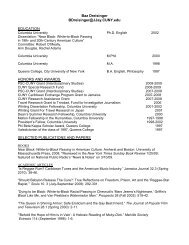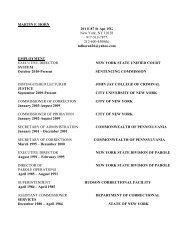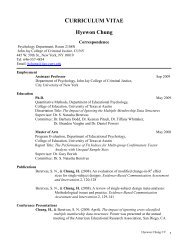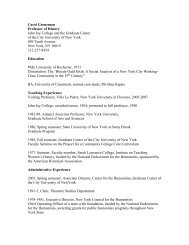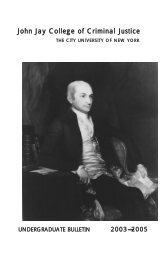Bulletin - John Jay College Of Criminal Justice - CUNY
Bulletin - John Jay College Of Criminal Justice - CUNY
Bulletin - John Jay College Of Criminal Justice - CUNY
Create successful ePaper yourself
Turn your PDF publications into a flip-book with our unique Google optimized e-Paper software.
Courses <strong>Of</strong>fered<br />
HIS 265 Class, Race and Family in Latin American<br />
History (Same course as LLS 265)<br />
3 hours, 3 credits<br />
Class structure, slavery, and race relations and the organization of the<br />
family will be examined in the colonial and neocolonial eras of Latin<br />
American history. A comparative approach, emphasizing urban and<br />
rural situations and economic change, will be stressed.<br />
Prerequisites: ENG 101, and sophomore standing or above or<br />
permission of the section instructor<br />
HIS 267 History of Caribbean Migrations to the<br />
United States (Same course as AAH 267 and LLS 267)<br />
3 hours, 3 credits<br />
A comparative study of the most significant aspects of Caribbean<br />
migrations to the United States during the 20th century. Emphasis on the<br />
political, economic and social framework of the migration process.<br />
Special attention will be given to the contemporary situations of the<br />
Haitian, Latina/o, and West Indian communities in the United States.<br />
Prerequisites: ENG 101, and sophomore standing or above or<br />
permission of the section instructor<br />
HIS 274 China: 1650 – Present<br />
3 hours, 3 credits<br />
This course provides an introduction to Chinese history from 1650 to<br />
the present. We will sketch the major events of political history<br />
covering the rise and fall of the last imperial dynasty (Qing, 1644-<br />
1912), the first Republic (1912-1949) and the impact of foreign<br />
imperialism and communism, and the major developments in the<br />
People's Republic of China, tracing the historical roots of key issues<br />
in contemporary China. In addition, we will also take a social and<br />
cultural approach. In examining how Chinese society changed over<br />
time, we will focus on the ways in which the Chinese interacted with<br />
other societies, whether neighboring nomads or distant Europe,<br />
exploring Chinese history within a broad and comparative<br />
framework. We will also examine how traditional Chinese values<br />
were influenced by foreign ideas and technologies.<br />
Prerequisites: ENG 102 or 201, HIS 205 or HIS 232<br />
HIS 277 American Legal History<br />
3 hours, 3 credits<br />
An analysis of the forces and circumstances that have influenced the<br />
course of American civil, criminal, and Constitutional law from the<br />
17th century to the present. The course concentrates on the change from<br />
English-based common law through the rise of industrial capitalism in the<br />
late 19th century and the development of the modern welfare state in the<br />
20th century and emphasizes such developments as the growth of the<br />
contract and corporate law, the use of litigation as an economic weapon,<br />
the rise of an independent judiciary and the ensuing conflict with the<br />
legislatures of both nation and state, the role of the legal profession in<br />
shaping the legal system, and the social role of law in American life.<br />
Prerequisites: ENG 101 and sophomore standing or above<br />
HIS 290 Selected Topics in History<br />
3 hours, 3 credits<br />
Specific study of a topic chosen by the instructor.<br />
Prerequisites: ENG 101 and sophomore standing or above<br />
HIS 300 Research Methods in History<br />
3 hours, 3 credits<br />
Participating in scholarly historical research requires a set of skills<br />
that will allow students to locate, prioritize, analyze, and write about<br />
primary sources. Students will learn how to find a variety of<br />
different kinds of sources and how to reckon with them once they<br />
have been found. It will also expand the knowledge of<br />
historiography gained in the previous required course,<br />
Historiography, by explaining how to locate secondary sources<br />
relevant to a variety of research interests and primary sources.<br />
Finally, it will introduce students to the process of contextualizing<br />
92



